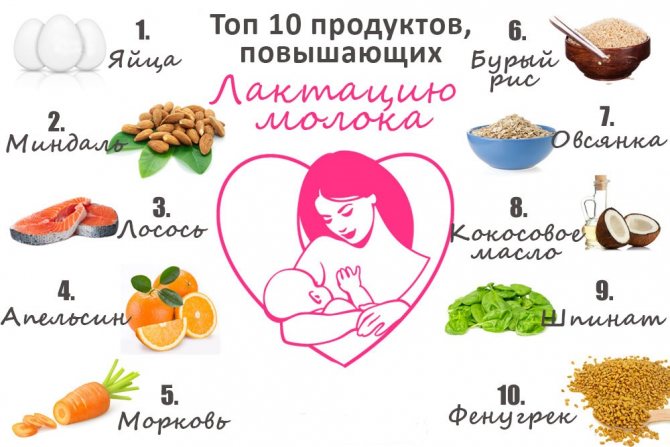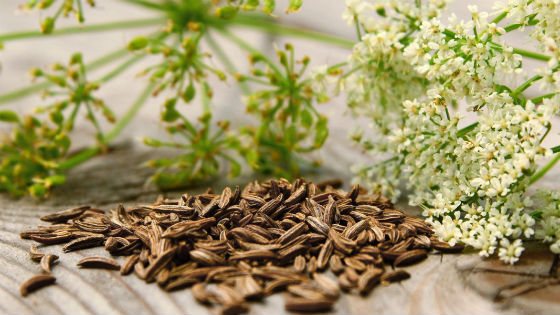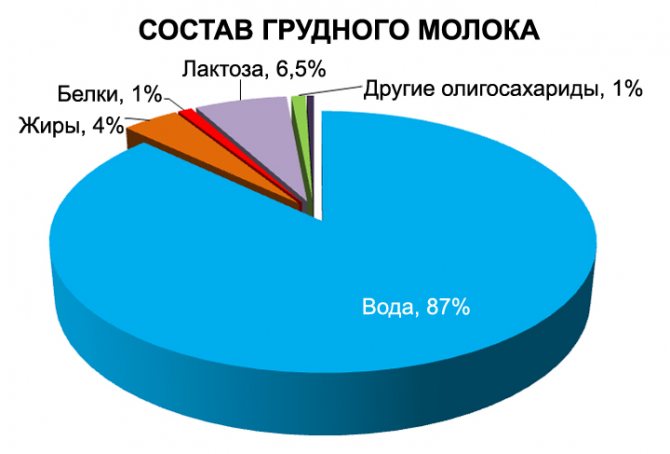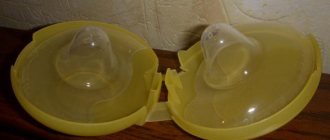Lack of breast milk is a problem that many mothers face, and it causes discomfort not only for parents, but also for the baby. He doesn’t eat enough, cries, the mood of everyone around him drops, a reasonable question arises - how to quickly increase lactation? Not every mother wants to switch her baby to formula, because breast milk is the source of all the vitamins and nutrients necessary to maintain good health and natural immunity. Today we need to figure out why the amount of milk may decrease, and what effective ways to solve the problem exist.
Basic principles of breastfeeding
It is recommended to establish the feeding process almost immediately.
The baby should be put to the breast within the first hour after birth to stimulate the production of colostrum. From the very first time it is necessary to teach the baby to grasp the nipple correctly; this moment is important for high-quality emptying of the mammary gland and preventing cracks in the skin. A feeding position is also important, which will allow the baby to fully latch onto the breast, so that it does not cause pain to the mother and fully stimulates milk production. How to increase milk flow while breastfeeding? First of all, organize the correct regime:
- You need to put your baby to the breast on demand, and not every few hours, as was done before;
- you should not overfeed your baby, he knows how much food he needs;
- you cannot refuse night feedings - this increases the production of prolactin; it is recommended to feed at night at least 3 times;
- there is no need to supplement the formula - the baby can stop breastfeeding and choose an easier way to get milk (from a bottle).
We must remember! These are the basic principles of maintaining full lactation, by observing which every mother will achieve the correct growth and development of the baby.
Factors affecting milk quantity

To increase breast lactation, a woman must follow a number of rules that will avoid a lack of milk. Factors that directly affect its full production include:
- proper rest - many mothers try to redo things while the child is sleeping, which leads to lack of sleep and chronic fatigue;
- maintaining a woman’s health – if she is sick, her milk supply may decrease;
- the situation in the family and the emotional state of the mother;
- regular feeding of the baby to the breast;
- mastering the correct feeding technique, choosing comfortable positions, preventing the appearance of cracked nipples.
What else increases milk lactation in lactating women? The mother’s desire to continue feeding and the lack of haste to transfer the baby to artificial formula is an important point.
Why is there not enough breast milk?
The process of breastfeeding is natural, it is regulated by the child himself and his mother’s body. Sometimes the process is disrupted and the total amount of milk decreases, the baby begins to be capricious from malnutrition. The reason for this state of affairs may be a lactation crisis, which is a natural process that you should not worry about.
Various literary sources interpret the concept of lactation crisis differently. This is the name for a temporary decrease in the amount of milk produced by the body of a nursing mother or a sudden lack of milk caused by the baby’s increased appetite.
Experts have not come to a consensus regarding the causes of this phenomenon. Some believe that the amount of breast milk is directly dependent on the waxing and waning phases of the moon. Others are of the opinion that the amount of milk is not decreasing, but the whole point is that the amount of milk, which until recently was sufficient to satisfy the baby’s appetite, is not so today, since there is a growth spurt.
Lactation crises usually occur between the third and sixth weeks of a child’s life and at three, seven, eleven months and a year. Usually the crisis lasts three or four days, but never lasts longer than one week.
All this time, the mother thinks that her child is hungry. At the same time, he drinks milk from both breasts, he becomes capricious, puts more and more pressure on the breast, and gets nervous.
All this does not mean at all that during the indicated periods the woman will not have enough milk. Many women do not even suspect the existence of such days and feed their children as if nothing had happened for a year, two or more.
There is not enough breast milk, what should I do?
If the fact of a lack of breast milk for feeding is confirmed, the woman can seek advice from a specialist, if such a possibility exists. In the event that such an opportunity is not available, you have to deal with this problem yourself.
Today, more and more experts are inclined to believe that a newborn baby should be fed according to his demand, and not according to the clock. The child knows better when he should eat. However, if your baby is not feeding well and is gaining weight, you should feed him every two hours. At night, in order to feed, the baby should be woken up every three or four hours.
For the entire time that the breastfeeding process is being established, it is extremely important to eliminate all pacifiers and nipples; you should also not give the baby water to drink in order to compensate for the lack of milk. When feeding a child with formula, this should be done with a spoon or syringe, but a bottle cannot be used for this purpose.
If it is determined that the baby does not have enough breast milk, the woman should adhere to the proper diet and regimen. You should eat hot food three times a day. The diet of a nursing mother should include all kinds of cereals, pasta made from durum wheat, meat, fish, eggs, poultry, baked, boiled and stewed vegetables. When a month has passed after childbirth, it is necessary to add raw fruits and vegetables and fermented milk products to the diet.
The mother is advised to drink a lot during breastfeeding. Tea, preferably with milk, a variety of compotes, jelly, and rosehip infusions are good options. A woman should always keep a cup of drink next to her.

Reasons for decreased milk production
How to increase lactation if milk disappears or has disappeared? You need to make sure there are no provoking factors before transferring your baby to formula feeding. These include:
- excessive physical and psycho-emotional stress;
- improper attachment to the breast;
- refusal of night feedings;
- ignoring simple exercises to maintain full lactation;
- passion for pacifiers;
- rare skin-to-skin contact with the baby – it is necessary for the production of lactogenic hormones, which increases during rocking, carrying and tactile caresses.
Important! Another reason for decreased breast milk production is considered to be poor nutrition. If a mother is addicted to coffee, canned food, ready-made sauces, fast food, or drinks alcoholic beverages, milk production may decrease sharply.

Chronic fatigue and frequent stress can cause decreased milk production
How to speed up milk flow after childbirth
All women know that breast milk is the best food for a newborn. But not everyone knows the benefits of colostrum.
When a mother does not produce milk after giving birth, but continues to produce the same yellowish fluid as during pregnancy, she may panic, deciding that the milk will never come.
But in vain, because this is a normal phenomenon: mature milk is undesirable for a baby in the first hours, and even 24 hours.
Colostrum is the most suitable food for a child in the first stages of adaptation to a new environment.
It contains much more immune and nutrients, and the ratio of different groups of organic compounds is optimal. A small amount (up to 100 ml per knock) is also provided by nature: the volume of a newborn’s stomach is only 7 ml.
Interesting! When menstruation begins after childbirth - norms and deviations
But in the first few days after giving birth, a young mother must follow the rules, thanks to which colostrum will still be replaced by breast milk:
1 The baby needs to be put to the breast often, at least once every 2.5 hours during the day and 3 times at night. It is not advisable to use pacifiers, bottles, or supplement your baby's food in the first weeks.
2 You should try to feed both mammary glands alternately in one feeding session. The left and right breasts function independently of each other; their equal stimulation is necessary.
3 Mom and baby sit in a comfortable position, the baby should press his chin and tip of his nose to the chest (so that this does not interfere with breathing) and cover most of the areola, not just the nipple.
4 After feeding, you need to try to squeeze out at least a couple more drops of colostrum (and in the future - milk) - at the next feeding, more of it will arrive (read about increasing lactation on moe1.ru).
If the baby is not put to the breast frequently, a special substance accumulates in the gland - a factor that inhibits (suppresses) lactation (FIL - it signals the body that milk is not in demand and lactation is not advisable).
With a long break in feeding (or pumping), the production of breast milk stops. To prevent the accumulation of the inhibitor, you need to feed the baby more often.
Some doctors advise women to begin breast stimulation in the last weeks of pregnancy, using a bra made of hard fabric. But the material should not be too rough, otherwise the skin will be injured.
How to understand that breast milk has arrived after childbirth - a woman will notice it immediately. The glands harden, increase in size, and become hot (body temperature may also increase).
If the hot flush is heavy (for example, the woman drank a lot of liquid), you need to consult your doctor about how to strain breast milk after childbirth.
If you try to do this yourself, without experience, you can harm yourself and injure your breasts, or the procedure simply will not bring any effect.
Interesting! Postpartum depression: how to get rid of guilt
Signs that there is not enough milk
How to increase milk production if lactation has decreased and the baby is not getting enough? This question is asked by many mothers. First you need to learn about the signs by which you can guess about its lack:
- the baby requires the breast too often;
- the feeding process takes 3-5 minutes, after which the baby abandons the breast and cries;
- the swallowing reflex during feeding is practically invisible;
- the baby is not gaining weight well;
- the baby becomes lethargic, his skin is pale, he often cries and sleeps poorly.
Of course, such signs may indicate problems with the baby’s health, but the mother must make sure that there is enough milk, and changes in the baby’s behavior and well-being are not associated with constant hunger.
How to check if your baby has enough milk?

If the baby is calm and sleeps well, then this is a sign that he is getting enough breast milk.
What to do if there is little or less breast milk? First, check whether the child really is not eating enough, and this is not unnecessary worry for the mother. Here are a few rules for determining sufficient lactation:
- the baby wakes up to eat every 2-3 hours, no more often;
- he sleeps peacefully and rarely worries;
- weight gain is stable (from 125 to 215 grams per week);
- the child is cheerful, healthy in appearance, complexion pink, skin clear;
- the baby pees up to 12 times a day, and poops 4-5 times;
- the urine is light, the feces are of a uniform consistency, without green impurities.
If all points are positive, there is nothing to worry about; some mothers are just worried about the baby being fed and healthy (sometimes unnecessarily). When signs of malnutrition are evident, measures should be taken to restore lactation.
The baby does not have enough breast milk
Any mother often worries about whether her baby will have enough breast milk, while the question of its excess almost never arises.
The whole problem is to accurately determine that the baby does not have enough breast milk and what should be done in this case. A lack of milk for a breastfed baby is unpleasant because the baby will begin to lose weight as a result of a lack of nutrients. Lack of breast milk can be determined by the following signs:
- no weight gain during monthly weighing;
- the child shows anxiety, constantly pulls away from the breast, after which he again greedily grabs the nipple;
- The baby makes a lot of sucking movements with a minimum of swallowing. The normal ratio is one swallowing movement to four sucking movements;
- the baby cannot withstand the required time intervals between feedings, which range from two to three hours.
- The child’s total amount of urine excreted sharply decreases and in general he begins to urinate rarely. During the first month of his life, a child, as a rule, urinates every hour; by the time he is one year old, he urinates once every two hours.
If a nursing mother has doubts about the baby’s lack of breast milk, it is necessary to carry out control feeding and weighing. For these purposes, special scales are used that show weight with an accuracy of one gram. They weigh the baby immediately before feeding and immediately after it, in order to accurately determine the volume of milk that he sucked. A similar procedure should be carried out several times during the day in order to accurately determine the total and average volume of milk that was sucked. You should always remember that the normal amount of milk sucked during the day is one fifth of the child’s body weight.
Ways to increase breast milk supply
How to increase the insufficient amount of milk during breastfeeding, when the baby is not gaining weight well, is apathetic, lethargic and sleeps poorly? First of all, do not make hasty decisions about introducing artificial formulas, but try to establish milk production in the following ways:
- Feed more often, reducing the intervals between feedings.
- Keep your baby at your breast as long as he will nurse, even if he seems to be sleeping.
- Offer the second breast when the baby stops swallowing.
- Do not pull out the baby's nipple until he releases it himself, even if this process takes a long time.
- From the first days, teach your baby to correctly grasp the areola area, and not just the tip of the nipple.
- Do not give the baby pacifiers or underfeed.
- Change breasts more often if your baby sucks weakly.
Attention! The main advice is that mom should maintain peace of mind and not get nervous. How to increase the amount of breast milk if her emotional state is unstable? It is unlikely that the event will be successful in this case.
Products and nutrition to increase lactation

Products to increase lactation in a nursing mother should contain a maximum of essential nutrients. To regulate nutrition, a woman is prescribed a diet that includes a set of the following products:
- milk porridge with added fruit (buckwheat and oatmeal are especially useful);
- honey;
- lean varieties of fish and meat;
- fresh and boiled vegetables (carrots, bell peppers, onions);
- boiled eggs;
- curd products;
- black bread;
- butter;
- fruits (preferably apples or pears);
- dairy and fermented milk products.
What else to eat to increase lactation? Hot broths, soups with sea fish, watermelons and different types of nuts are useful. To season main courses and salads, you need to use vegetable oil every day - it is rich in vitamin E and healthy acids.
Warm drink
Drinking warm drinks and liquid dishes such as chicken broths and fish broths will help increase lactation. It is useful to drink tea with milk, compotes and fruit drinks from various fruits, decoctions of medicinal herbs (chamomile, rose hips, mint, sage, dill), freshly squeezed juices or boiled water. We must not forget about the benefits of dairy and fermented milk products - kefir, fermented baked milk, boiled milk.
How to increase breast milk production with drinks? The main condition is to take them warm, and not hot (cold), preferably 30 minutes before the intended application to the breast. Coffee lovers can replace the drink with a special type - barley. It increases lactation and does not cause side effects, like natural ones.

Feeding on demand
How to increase milk production naturally? There is no need to accustom the baby to the regime and force him to wait for several hours for latching, as was the practice before. Especially if the mother has problems with lack of milk. Frequent feeding of the baby to the glands stimulates the production of the required amount of milk, because the breast adapts to the needs of the baby.
Feeding on demand is an important condition that must be observed in the first months of a baby’s life in order to establish the lactation process and provide the baby’s body with the necessary amount of nutrients and vitamins supplied with mother’s milk. With each application, oxytocin and prolactin are released in the gland - substances that stimulate full milk production.
Night feedings
You need to put your baby to your breast at night at least 2-3 times, this is necessary for the full production of the substance prolactin. It is actively secreted from 3 a.m. to 6 a.m., which is when the baby is allowed to breastfeed as much as he needs.
If a young mother ignores night feedings, her body believes that it produces enough milk, which means its production can be reduced. To maintain lactation, a woman should not allow such destructive changes in the body - the baby will stop eating and will not develop properly.
Pharmacy products

How to increase milk supply using pharmaceutical products? You can select the right drug with the help of a doctor if the lactation crisis is prolonged. There are several groups of such funds:
- Herbal teas. They are created for use by women during breastfeeding and contain natural herbs (dill, anise, sage, chamomile, lavender, mint). Such drinks have a tonic effect, increase lactation and immunity, and thanks to their pleasant taste, you can drink them several times daily.
- Tablets and dietary supplements. The preparations Laktogon, Mlekoin and Apilak are taken with meals and contain natural ingredients (herbs and royal jelly). They help to establish lactation, even if milk production has practically stopped.
- Milk formulas. You can drink them like milkshakes, diluting them with boiled water. They increase the amount of milk and saturate the mother’s body with vitamins and minerals. Effective products – Lactamil, Femilak, Mama+.
Note! The remedy must be selected by a specialist who knows and observes the feeding history in order to choose the best option - a mixture, tea, or a medicinal drug.
ethnoscience
You can increase breast milk lactation at home. For this purpose, you can use vitamin drinks and decoctions of medicinal plants, sold in pharmacies and prepared independently.
Cumin decoction has a beneficial effect on lactation. To prepare, you need to brew a teaspoon of raw material with a glass of water, boil for 10 minutes and leave for half an hour. After straining, drink the decoction as tea, adding a spoonful of honey to improve the taste.
You can use anise seeds. They are infused in a thermos for about 3 hours, after pouring a glass of boiled hot water. Before each feeding you need to drink 50 ml of warm infusion. Unlike traditional ones, folk remedies for increasing the lactation of breast milk can be drunk until the very end of feeding the baby, until he refuses to breastfeed himself.

Exposure to heat
You can increase lactation using thermal procedures. To produce more milk, it is very useful to take a warm shower, and you need to direct the stream of water to the breast that the baby has just emptied. The movements should be circular, from the nipple to the edges of the breast, the water should not be made too hot.
Warm baths with the addition of herb, chamomile or lavender are also useful. They soothe and increase lactation naturally. During rest or household chores, you can cover the mammary glands with a warm towel, but do not overheat them, in order to avoid the development of mastitis.
Pumping after feedings
In order to increase lactation, at the end of feeding it is necessary to express the remaining milk from the gland that the baby emptied. This stimulates her to produce more milk, sending signals that the amount currently produced is not enough. Expressing should be done with cleanly washed hands, after washing or wiping the breasts with boiled water.
If after feeding the mother feels that there is very little milk left and she is unable to express by hand, you can use a soft breast pump. You can choose a manual or automatic option, which will help you reproduce the baby’s natural sucking movements.
Self-massage of the mammary glands
What to do if milk is still not produced in sufficient quantities? Self-massage of the mammary glands will help. It should be done after feeding, with clean hands, on the breast from which the baby has just eaten. Movements should be circular, neat, without excessive pressure. You need to start massaging from the nipple and move to the edges of the mammary gland, continuing to perform movements for 5-7 minutes.

Water treatments
Regular use of a contrast shower increases lactation and helps a young mother get rid of excessive emotional stress. During feeding, immerse your feet in warm, but not hot water, this will help increase the flow of milk to the breast. Breast baths have a good effect - it’s better to do them before going to bed. Hot water is poured into a basin, the mammary glands are lowered into it and held for 15 minutes, adding hotter water as it cools. After the procedure, they rub themselves dry, change into pajamas, and then lie down under a warm blanket.
Helpful advice! A good effect is achieved by applying warm compresses made of terry cloth soaked in hot water. You need to keep the compress until it cools, covering it with a warm towel on top. Do not do this if you have mastitis or lactostasis!
Psychological moment
It is possible to increase the amount of breast milk naturally if you provide adequate conditions for mother and baby for psychological and emotional rest:
- Walking more in the fresh air is good for the baby’s health and the mother’s mood;
- during the daytime rest, sleep next to the baby - tactile contact is very important for the baby, and a rested mother is full of energy and positive emotions;
- occasionally ask your loved ones to sit with the baby while the mother goes to the store, hairdresser, or just soaks in the bath;
- Maintaining confidence that artificial formula cannot replace natural milk for the baby, and giving up breastfeeding is unwise.
A positive psychological attitude is the key to success in increasing lactation, since the negative psychological state of a young mother is reflected in a decrease in the quality and quantity of milk.
How to understand that there is not enough breast milk
Many nursing mothers worry about whether their baby is getting enough to eat. It’s one thing if feeding is done from a bottle, when you can immediately determine how much has been consumed, and quite another thing is breastfeeding, in which it is quite difficult to determine by eye the amount of milk the baby has eaten. In order to know for sure whether the child is full or not, you should focus on some objective indicators.
- You can count the number of diapers that the child managed to wet. For a baby who gets enough nutrients, it is normal to urinate six or eight times during the day. To get the real picture, it makes sense to abandon disposable diapers in favor of gauze or cloth diapers for one or two days.
- It is worth carefully examining the child’s stool. If it is yellow in color and has a granular structure, possibly with some undigested lumps, then this indicates that the stool is normal. A baby who receives a sufficient amount of milk, which is high in calories, has stool once or twice a day, since mother's milk has a significant laxative effect.
- Green stool in a child may indicate lactase deficiency. This means that as a result of feeding, he sucks out the foremilk, so called because it contains a lot of sugar, but does not reach the so-called hind milk, which has the greatest nutritional value. Maybe the whole question is precisely that for his full development it is precisely this diet that he lacks.
- The breasts should be carefully assessed before and immediately after feeding. If after feeding the breast softens and falls, despite the fact that before feeding it was full and tight, it means that the child is full. If your breasts leak between feedings, this is evidence that there is good milk production.
- It makes sense to monitor how the baby behaves during feeding. If he releases the breast on his own and then falls asleep, or does not sleep, but looks cheerful and his cheeks are rounded, it means he is full. If, after the child has eaten, he regurgitates a curd mass or whey, this is evidence that there is no problem of lack of milk at all - on the contrary, the child is overfed. However, if regurgitation of milk occurs, you should contact your pediatrician, as there may be other problems.
- You should pay attention to how the child gains weight. With a normal diet, in the first two months of life, children gain from one hundred to two hundred grams of weight per week, up to six months, 500-1100 grams per month, from six months to a year, 550-650 grams per month. These are average parameters, since weight gain depends on a number of different factors, such as the child’s weight at birth, his height, and physique.
- The following test can help determine whether the baby is getting enough breast milk or not: you need to squeeze the area of the baby’s skin above the bones and muscles with two fingers. If he gets enough milk, his skin is firm to the touch with a good layer of fat. Skin that separates loosely from bones and muscles and is wrinkled to the touch indicates a lack of milk for the baby. It is necessary to contact your pediatrician and establish breastfeeding. Perhaps the pediatrician will prescribe a supplementary formula if necessary. In any case, you should consult a pediatrician, since the issue of feeding is very important and it is advisable to avoid mistakes in it.
How to increase the fat content of milk?

Normally, the fat content should be about 280 kJ, but the figure is not exact, and each serving of milk differs from the previous one in composition and amount of fat. Therefore, determining whether milk is rich enough is difficult. What can be done:
- drink more tea, water and other liquids (water does not reduce the fat content of milk);
- do not distribute feedings over time;
- do not express the first portion of milk, giving the baby only the back portion - the front portion contains less fat, but more vitamins and liquids to eliminate thirst;
- eat rationally - get maximum calcium (from cottage cheese, fish, herbs, carrots), ensure a 30% supply of fats in the menu and a 20% supply of proteins;
- do not go on diets in pursuit of a slim figure while breastfeeding.
Ideally, to determine the fat content of milk, you can have it analyzed, or consult a doctor who will observe the feeding process and decide whether it is necessary to artificially increase the fat content.
Myths about means to improve lactation
What to do if there is not enough milk, the baby does not eat enough and cries? Puzzled by this problem, many mothers quickly go to the pharmacy for a remedy that will allow the gland to produce more milk. A pharmacist may recommend a product from a series of fortifiers (milk formulas for mothers) that increase fat content and increase milk production. But such drugs are quite questionable, since it is quite difficult to improve the fat content and increase the amount of milk only by taking fortifiers.
With the help of compounds like Nutrilon, you can only regulate the mother’s diet and establish the baby’s feeding regime. Of course, such mixtures enrich the body with vitamins and microelements, preventing a lactation crisis, eliminating brittle nails, hair, and weak teeth. But it is unlikely that it will be possible to improve lactation only with the help of a miracle cure - an integrated approach is needed here.
As you can see, increasing lactation while breastfeeding is a troublesome task, but worth the effort. Breast milk is an ideal food for babies; it saturates the body with vitamins, improves immunity, promotes comfortable digestion, and brings mother and child closer together during feeding. In addition to the listed ways to increase lactation, the mother must remain calm and confident that the feeding process will improve, otherwise no supplements or procedures will help increase milk volume.











